CLIMATE AND ENVIRONMENTAL CHANGE IN THE MEDITERRANEAN – MAIN FACTS
Summary : The Mediterranean basin is a region of cultural and landscape richness, as well as exceptional diversity. Climate and environmental changes resulting from human activity in this region have accelerated for the last few decades. During this period the average annual temperatures of the air and the sea have increased, sea-level has risen and the water acidification is ongoing. Conditions tend to be warmer and drier. These changes imply numerous risks for ecosystems and for human well-being. Therefore, it is crucial to update and consolidate the best scientific knowledge about climate and environmental change in the Mediterranean basin and to render it accessible to policy-makers, key stakeholders and citizens. This is the objective of the first MedECC report.
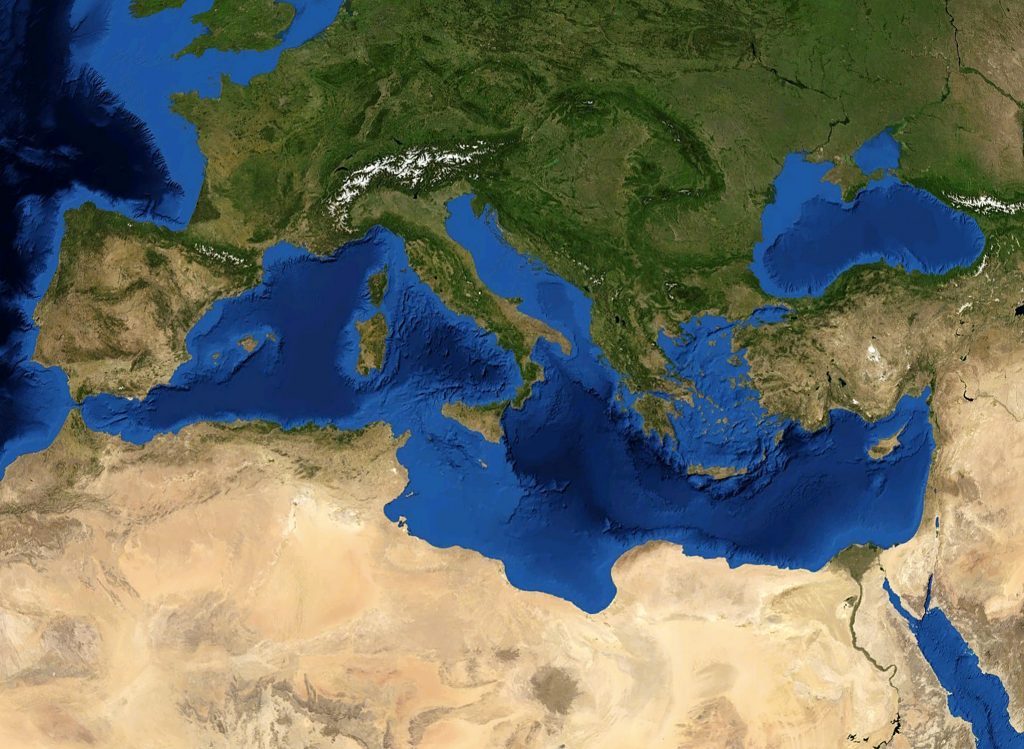 The Mediterranean Sea is surrounded by three continents: Africa, Asia and Europe. The cultural richness around the Mediterranean is exceptional. This is also a region of constant change. It is shaped by human activities, including land use changes, industry and population growth, combined with the growth of coastal urban regions (UNEP/MAP 2012). This pressure is further amplified by the development of tourism in highly attractive Mediterranean coastal areas, and rapidly evolving changes in consumption patterns, as a result of increasing development (Plan Bleu 2012). The Mediterranean Sea is also one of the world’s busiest shipping routes (UNEP/MAP-Plan Bleu 2009). Moreover, it is a region of contrasts, as it includes countries with very different levels of income and social development. Despite a significant progress made in developing countries on the Southern shore of the Mediterranean, North-South fracture remains. The region faces unequal distribution of resources, conflicts and large-scale migration (AllEnvi 2016).
The Mediterranean Sea is surrounded by three continents: Africa, Asia and Europe. The cultural richness around the Mediterranean is exceptional. This is also a region of constant change. It is shaped by human activities, including land use changes, industry and population growth, combined with the growth of coastal urban regions (UNEP/MAP 2012). This pressure is further amplified by the development of tourism in highly attractive Mediterranean coastal areas, and rapidly evolving changes in consumption patterns, as a result of increasing development (Plan Bleu 2012). The Mediterranean Sea is also one of the world’s busiest shipping routes (UNEP/MAP-Plan Bleu 2009). Moreover, it is a region of contrasts, as it includes countries with very different levels of income and social development. Despite a significant progress made in developing countries on the Southern shore of the Mediterranean, North-South fracture remains. The region faces unequal distribution of resources, conflicts and large-scale migration (AllEnvi 2016).
The Mediterranean region is also characterized by the richness and the diversity of its landscapes, going from subtropical deserts to temperate mid-latitude regions. It is a hotspot of biodiversity. The Mediterranean Sea hosts 4% to 18% of all identified marine species, which is considerable given that it only accounts for 0.82% of the global ocean surface (Coll et al. 2010). This biodiversity hotspot is threatened by several and often synergistic anthropogenic stressors (Boero 2015).
Moreover, the Mediterranean region is exposed to several natural risks, like earthquakes, volcano eruptions, floods, fires or droughts. In this complex situation, the Mediterranean faces new challenges, due to global climate change. Based on global climate scenarios, the Mediterranean Sea has been classified as one of the most responsive regions to climate change (Giorgi 2006). In the Mediterranean region, average annual temperatures are now 1.4 °C higher than during the period 1880-1899, well above current global warming trends, especially during summer (Fig. 1). As for the future projections, the 2 °C global mean temperature target implies 3 °C warming in hot temperature extremes in the Mediterranean region (Seneviratne et al. 2016). Depending on the climate scenario (RCP: Representative Concentration Pathway) and the season, a rise in temperature from 2 to 6 ° C by 2100 is expected in the Mediterranean (for summer temperatures: Fig. 2; IPCC 2013). High temperature events and heat waves are likely to become more frequent and/or more extreme (Jacob et al. 2014).
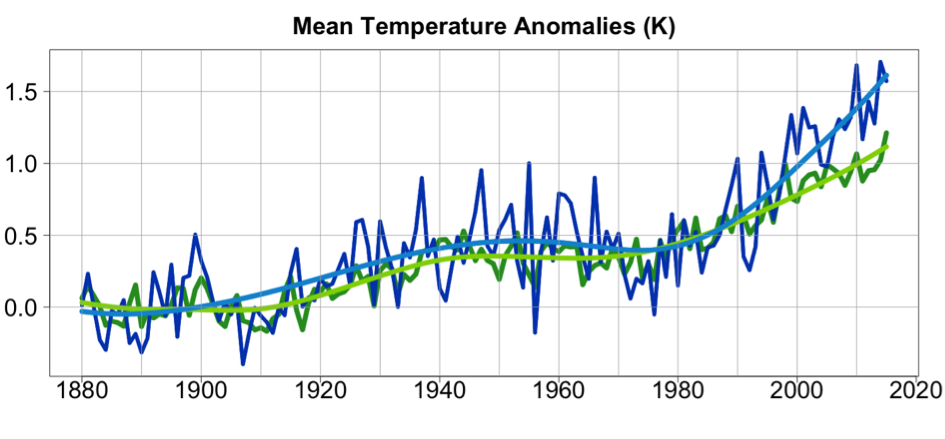
Fig. 1. Warming of the atmosphere (annual mean temperature anomalies with respect to the period 1880-1899), in the Mediterranean Basin (blue lines, with and without smoothing) and for the globe (green line). In the Mediterranean region, average annual temperatures are now 1.4 °C higher than during the period 1880-1899, well above current global warming trends. Data from Berkeley Earth available at http://berkeleyearth.org/
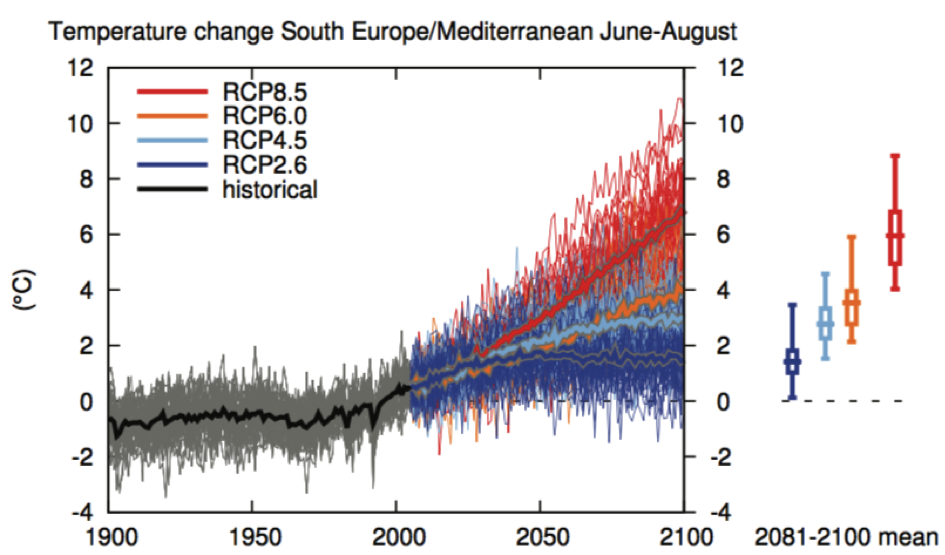
Fig. 2. Time series of temperature change relative to 1986-2005 averaged over land grid points in the region South Europe/Mediterranean (30°N to 45 °N, 10°W to 40°E) in June to August. On the right-hand side the 5th, 25th, 50th (median), 75th and 95th percentiles of the distribution of 20-year mean changes are given for 2081-2100 in the four RCP scenarios. A rise in temperature from 2 to 6 ° C by 2100 is expected in the Mediterranean.
The sea-level in the Mediterranean has risen between 1945-2000 at a rate of 0.7±0.2 mm/yr (Calafat and Gomis 2009). The estimate rise during the last two decades was of about 3 cm/decade (Tsimplis et al. 2013). The future total Mediterranean basin averaged sea-level rise has been estimated to be between 9.8 and 25.6 cm by 2040–2050 depending on the scenario (Galassi and Spada 2014). Warming of the Mediterranean Sea surface is currently estimated at 0.4 °C/decade for the period 1985-2006 (Nykjaer 2009). Concerning future changes, the Balearic Islands, the northwest Ionian, the Aegean and Levantine Seas have been identified as the regions with maximum increase of sea surface temperature (Fig. 3; Adloff et al. 2015). The Mediterranean Sea acidification is already detectable (Howes et al. 2015).
Analyses of long-term trends in the Mediterranean region show that annual mean conditions tend to be warmer and drier (UNEP/MAP-Plan Bleu 2009). Frequency and intensity of droughts have increased significantly in the Mediterranean since 1950 (Vicente-Serrano et al. 2014). The increase of the length of dry spell (days) is expected (Schleussner et al. 2016) and the decrease in precipitation, especially in summer and with important regional differences (for summer, Fig. 4; IPCC 2013).
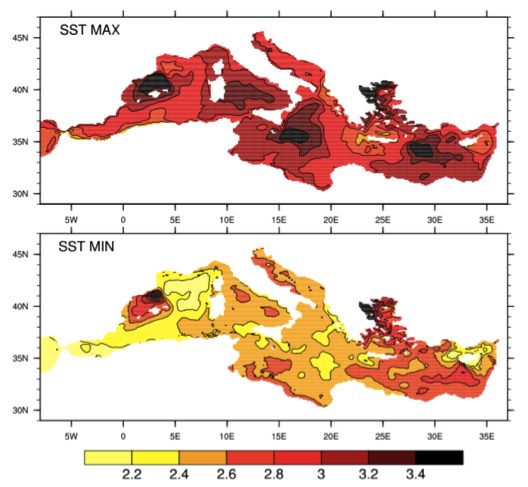
Fig. 3. Expected minimum and maximum changes in sea surface temperature for the 2070–2099 period (vs. 1961–1990) based on a 6-member ensemble covering various sources of uncertain (°C). The Balearic Islands, the northwest Ionian, the Aegean and Levantine Seas have been identified as the regions with maximum increase of sea surface temperature (refer to : Adloff et al. 2015, for the details of the analysis)
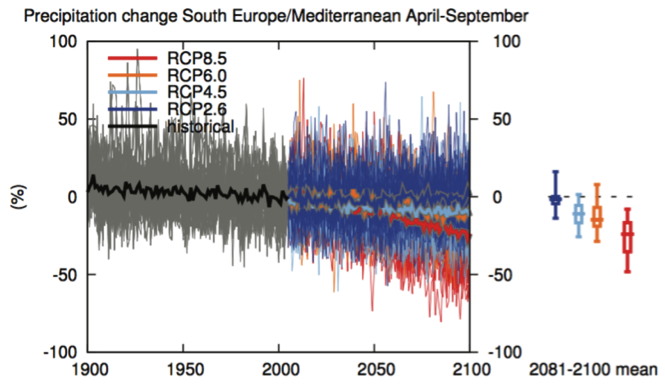
Fig. 4. Time series of relative change relative to 1986––2005 in precipitation averaged over land grid points in the region South Europe/Mediterranean (30°N to 45°N, 10°W to 40°E) in October to March. On the right–hand side the 5th, 25th, 50th (median), 75th and 95th percentiles of the distribution of 20-year mean changes are given for 2081-2100 in the four RCP scenarios. The decrease in precipitation, especially in summer is expected.
Consequences of climate change described here above imply numerous risks for ecosystems and for human well-being. In addition to direct consequences of climate change, there are numerous combined consequences of different environmental changes resulting from human pressures, like landscape and ecosystem degradation due to industrialization, urbanization and transport (pollution of air, water, soil and living resources) and unsustainable of use mineral and living resources of the land and the sea. Challenges resulting from these changes concern various domains, like fishing industry, agriculture, forest management and commercial and leisure activities.
In this context, taking into account the environment in economic and political decisions must be a priority for the future of the Mediterranean. Policy responses to climate change should be based on scientific evidence. Consideration of scientific evidence includes clear communication of uncertainties as part of normal practice. While the uncertainty indications could make the scientific assessment more difficult to include in policy-making, uncertainties should not be used as an excuse for inaction. On the contrary, the assessment should help people to better understand the complexity of links among climate, environmental and societal parameters. There is an urgent need to update and consolidate the best scientific knowledge about climate and environmental change in the Mediterranean basin and to render it accessible to policy-makers, key stakeholders and citizens. A substantial amount of observations and scientific capacity for risk assessment exist around the Mediterranean, but resources are unevenly distributed and some of the most vulnerable regions and economic sectors are insufficiently studied. There is also a widely shared concern that, in the Mediterranean region, research activities, monitoring data and other knowledge generation about climate change and other environmental changes are strongly biased to the North and insufficiently coordinated. Public and private decision-makers therefore have insufficient access to the existing knowledge. For all these reasons, MedECC is preparing its first MedECC report on the current state and risks of climate and environmental change in the Mediterranean.
30/01/2018; This article was produced by Katarzyna Marini with the support of Plan Bleu – UNEP/MAP.
References
- Adloff F, Somot S, Sevault F, Jorda G, Aznar R, Deque M, Herrmann M, Marcos M, Dubois C, Padorno E, Alvarez-Fanjul E, Gomis D (2015) Mediterranean Sea response to climate change in an ensemble of twenty first century scenarios. Climate Dynamics, 45 (9-10), 2775-2802
- AllEnvi (ed.) (2016) The Mediterranean region under climate change. Paris : IRD Editions, 736 pp.
- Boero F (2015) The future of the Mediterranean Sea Ecosystem: towards a different tomorrow. Rendiconti Lincei, 26, 3-12
- Calafat FM, Gomis D (2009) Reconstruction of Mediterranean sea level fields for the period 1945-2000. Global and Planetary Change 66(3-4), 225-234
- Coll M, Piroddi C, Steenbeek J, Kaschner K, Ben Rais Lasram F, Aguzzi J, et al. (2010) The Biodiversity of the Mediterranean Sea: Estimates, Patterns, and Threats. PLoS ONE 5(8): e11842
- Galassi G, Spada G (2014) Sea-level rise in the Mediterranean Sea by 2050: Roles of terrestrial ice melt, steric effects and glacial isostatic adjustment. Global and Planetary Change, 123, Part A, 55-66
- Giorgi F (2006) Climate changes hot-spots. Geophysical Research Letters, 33, L08707
- Giorgi F, Lionello P (2008) Climate change projects for the Mediterranean region. Gl. Planet. Change 63(2), 90- 104, doi: 10.1016/j.gloplacha.2007.09.005
- Howes EL, Stemmann L, Assailly C, Irisson J-O, Dima M, Bijma J, Gattuso J-P (2015) Pteropod time series from the North Western Mediterranean (1967−2003): impacts of pH and climate variability. Marine Ecology Progress Series, 531,193-206
- IPCC (2013) Climate Change 2013: The Physical Science Basis. Contribution of Working Group I to the Fifth Assessment Report of the Intergovernmental Panel on Climate Change [Stocker TF, D Qin, G-K Plattner, M Tignor, SK Allen, J Boschung, A Nauels, Y Xia, V Bex and PM Midgley (eds.)]. Cambridge University Press, Cambridge, United Kingdom and New York, NY, USA, 1535 pp.
- Jacob D, Petersen J, Eggert B, Alias A, Christensen OB, Bouwer LM, Braun A, Colette A, Déqué M, Georgievski G, Georgopoulou E, Gobiet A, Menut L, Nikulin G, Haensler A, Hempelmann N, Jones C, Keuler K, Kovats S, Kröner N, Kotlarski S, Kriegsmann A, Martin E, van Meijgaard E, Moseley C, Pfeifer S, Preuschmann S, Radermacher C, Radtke K, Rechid D, Rounsevell M, Samuelsson P, Somot S, Soussana J-F, Teichmann C, Valentini R, Vautard R, Weber B, Yiou P (2014) EURO-CORDEX: new high-resolution climate change projections for European impact research. Regional Environmental Change, 14(2), 563-578
- Nykjaer L (2009) Mediterranean Sea surface warming 1985-2006. Climate Research 39, 11-17
- Plan Bleu (2012) Tourism: Economic Activities and Sustainable Development, Plan Bleu Notes, No. 24
- Schleussner CF, Lissner TK, Fischer EM, Wohland J, Perrette M, Golly A, Rogelj J, Childers K, Schewe J, Frieler K, Mengel M, Hare W, Schaeffer M (2016) Differential climate impacts for policy-relevant limits to global warming: the case of 1.5 °C and 2 °C. Earth System Dynamics 7, 327-351
- Seneviratne SI, Donat MG, Pitman AJ, Knutti R and Wilby RL (2016) Allowable CO2 emissions based on regional and impact-related climate targets, Nature, 529 477–83
- Tsimplis MN, Calafat FM, Marcos M, Jordà G, Gomis D, Fenoglio-Marc L, Struglia MV, Josey SA, Chambers DP (2013) The effect of the NAO on sea level and on mass changes in the Mediterranean Sea. Journal of Geophysical Research: Oceans, 118, 944-952
- UNEP/MAP-Plan Bleu (2009) State of the Environment and Development in the Mediterranean, Report. Athens, Greece
- UNEP/MAP (2012) State of the Mediterranean Marine and Coastal Environment, Report. Athens, Greece
- Vicente-Serrano SM, Lopez-Moreno J-I, Beguería S, Lorenzo-Lacruz J, Sanchez-Lorenzo A, García- Ruiz JM, Azorin-Molina C, Morán-Tejeda E, Revuelto K, Trigo R, Coelho F, Espejo F (2014) Evidence of increasing drought severity caused by temperature rise in southern Europe. Environmental Research Letters, 9, 044001
